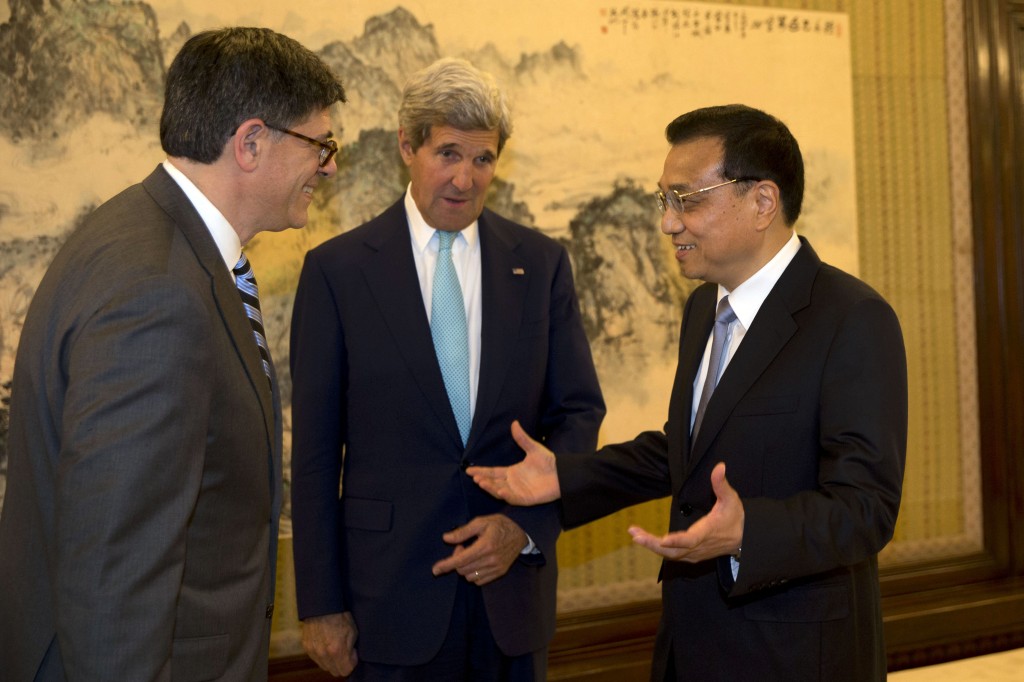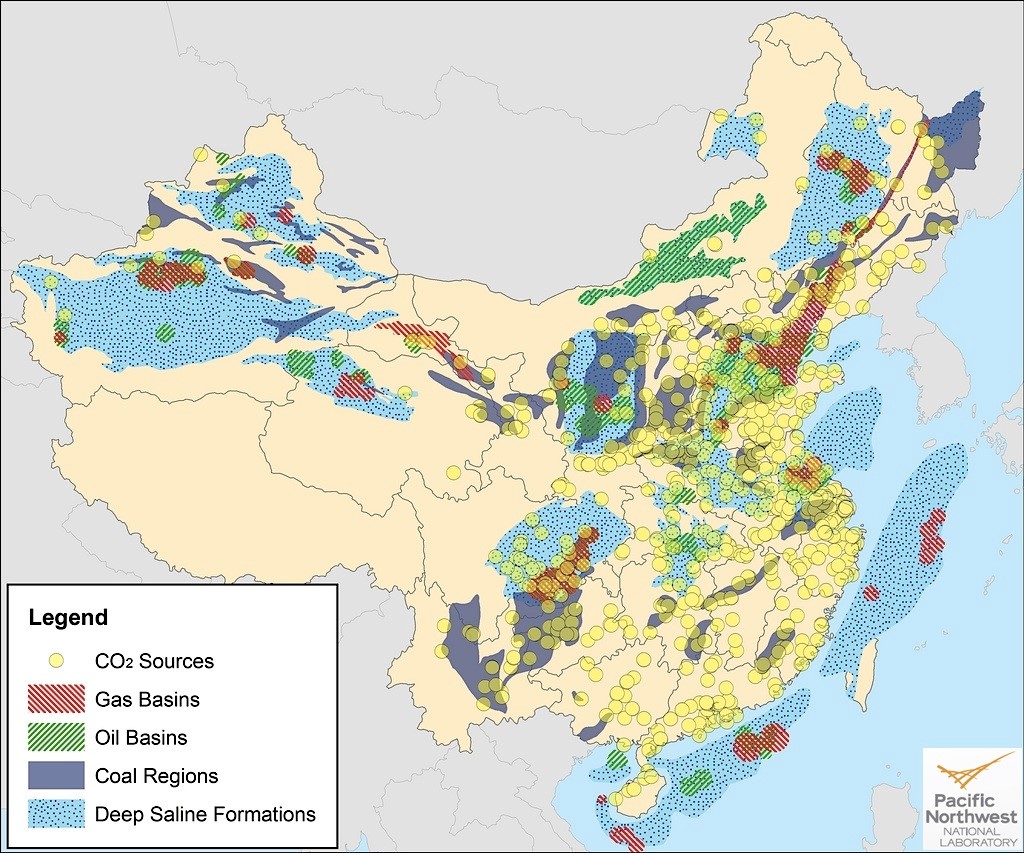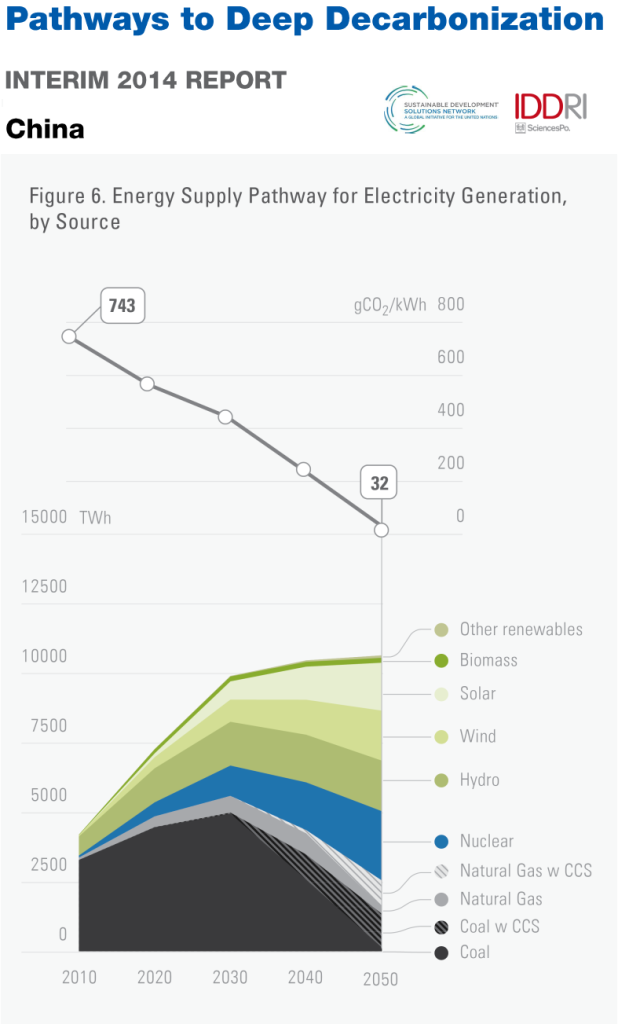Breaking Energy, July 15, 2014 (.pdf)
The Energy Collective, July 18, 2014
U.S. Secretary of State John Kerry (C) introduces U.S. Treasury Secretary Jacob Lew (L) to Chinese Premier Li Keqiang during a meeting at the Zhongnanhai leadership compound on July 10, 2014 in Beijing, China.China is the world’s largest coal producer and consumer and the world’s leading emitter of carbon dioxide emissions. China is also the world’s most populous country and is suffering from high levels of pollution due to its unrestrained fossil fuel use. China’s leadership is under a great deal of pressure to both reduce air pollution and to tackle its carbon emissions and they recognize the critical importance that CCS plays in these efforts. China has been working with USA over the last decade to collaborate on CCS development.
On July 8 senior delegations from the U.S. and China signed eight partnership agreements to cut greenhouse gasses. The agreements are collaborations between businesses and research institutions to develop demonstration projects and technology sharing.
The agreements were signed ahead of a two-day visit by top Obama administration officials including Secretary of State John Kerry, Treasury Secretary Jack Lew and Energy Secretary Ernest Moniz for the US-China Strategic and Economic Dialogue. The signing was attended by Todd Stern, the lead U.S. climate treaty negotiator, Obama advisor John Podesta, and Lee Zak, director of the U.S. Trade and Development agency as well as Xie Zhenhua, vice chairman of China’s National Development and Reform Commission.
The agreements include four on Carbon Capture, Utilization and Storage:
- Huaneng Clean Energy Research Institute and Summit Power Group LLC agreed to collaborate on clean coal power generation technology including IGCC and CO2-EOR. Summit are the developers of the Texas Clean Energy Project and have an existing strategic and investment alliance with Sinopec, the Chinese state owned oil company.
- West Virginia University, Yanchang Petroleum and Air Products and Chemicals will demonstrate oxy-combustion coal technology in northern Shaanxi province.
- The University of Kentucky will partner with Shanxi Coal International Energy Group and Air Products and Chemicals Inc on a feasibility study for a 350MW supercritical coal-fired power plant that can capture 2 million tons of CO2 per year.
- Sinopec and the University of Kentucky agreed to work on a large demonstration project to capture 1 million tons of CO2 per year that will be used for algae growth.
These agreements are the latest step in the relationship between USA and China on CCS research and development that dates back to 2005. In 2009 President Obama and then President Hu Jintao established the U.S.-China Clean Energy Research Centers, with one of the three centers focused on coal and CCUS. In April 2013, the Climate Change Working Group (CCWG) for the Strategic and Economic dialogue was established to deepen and extend large-scale, cooperative efforts. And in July 2013, the two countries committed to new action initiatives across five sustainability issues, including CCUS.
The U.S. State Department posts this statement on their U.S.-China Climate Change Working Group Fact Sheet highlighting the high level political attention that both countries give to carbon capture.
Increasing carbon capture, utilization, and storage (CCUS): Together, the United States and China account for more than 40 percent of global coal consumption. Emissions from coal combustion in the electric power and industrial sectors can be significantly reduced through CCUS. China and the United States will cooperate to overcome barriers to deploying CCUS by implementing several large-scale, integrated CCUS projects in both countries. These demonstrations will engage companies in both countries and allow for enhanced trade and commerce.
China is number 2 in the world, behind the USA in terms of active CCS projects. China has 12 large scale projects according to the Global CCS Institute, the USA has 19. CCS efforts in China are still relatively young and the sequestration numbers are relatively small, as there is not a historical EOR industry like the one that exists in the United States. Existing demonstration projects in China have resulted in the capture of around 270,000 tons of CO2 per year with utilization of more than 120,000 tons per year and storage of another 100,000 tons per year.
China has substantial geological sequestration capacity. Research by PNNL and the DOE found that China has 2,300 gigatons of CO2 storage capacity distributed widely throughout the country. An additional 780 gigatons of offshore capacity may also be available for industrialized coastal areas.
China is by far the world leader in deploying advanced coal gasification technologies and they are able to get the complex facilities built far faster with much lower costs than in the USA. It is believed that by combining China’s engineering capabilities and cost advantages with western advanced technologies and sequestration experience the technical and financial challenges to implementing CCS can be overcome. But many barriers remain in China including a lack of clear CCS policy, a price or cap on carbon, funding, and a mature EOR industry.
The need for CCS only grows stronger though. To achieve rapid decarbonization by the year 2050, it is estimated in a recent report by the UN Sustainable Development Solution Network that CCS must be equipped on 90% of coal power plants and 80% of natural gas power plants in China. This chart from the report illustrates that CCS is a vital component of the overall portfolio of solutions even as renewables and nuclear power are deployed along an aggressive schedule. If fossil fuel use does not fall as illustrated in this scenario, then the need for CCS becomes even more important.
These recent agreements are an encouraging sign that CCS technology development is slowly but surely moving forward. The USA and China are the critical world’s leaders in this important endeavor. Our two countries are both the leading coal consumers, carbon dioxide emitters, and industrial powerhouses. We both share the burden of responsibility, the wealth, and the technical capability of solving the engineering and financial problems to make CCS successful. We also have the benefit of reaping the rewards in terms of domestic jobs and economic growth, a cleaner environment, and the opportunity to export the technology solutions.


